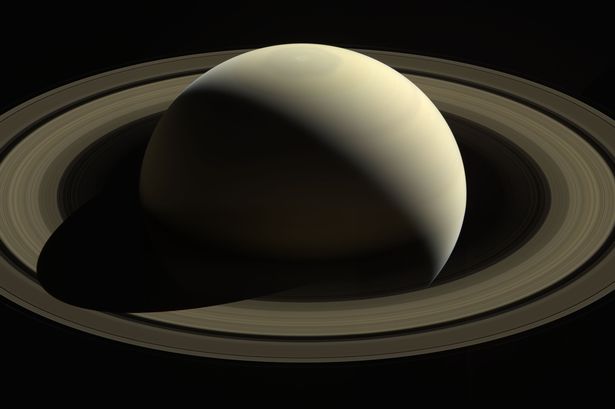Science
Saturn Dazzles in September: Best Viewing Times and Details

Saturn is set to offer a breathtaking display this month as it reaches opposition on September 21, 2023. At this time, Earth will align directly between Saturn and the Sun, allowing the planet to shine at its brightest and closest point of the year. This celestial event presents an excellent opportunity for stargazers to observe Saturn, which is renowned for its magnificent ring system.
The National Aeronautics and Space Administration (NASA) states that Saturn will be clearly visible to the naked eye throughout September, particularly in the eastern evening sky. For those equipped with a small telescope, the iconic rings of Saturn become visible, adding to the planet’s allure. As Saturn glows prominently in the night sky, it stands in contrast to the bright appearances of Venus and Jupiter, which dominate the eastern morning hours.
Historical Context and Scientific Insights
The captivating rings of Saturn were first identified as a continuous disk by Dutch astronomer Christiaan Huygens in 1655. Over three centuries later, NASA’s Voyager 1 spacecraft provided unprecedented images, revealing thousands of delicate ringlets surrounding the planet. Further analysis from the Cassini mission indicates that these rings likely formed around 200 million years ago, significantly contributing to Saturn’s unique appearance.
Saturn’s color variations arise from hydrocarbon hazes found above ammonia crystals in its upper cloud layers. The planet’s axial tilt of 27 degrees leads to seasonal changes, subtly altering its appearance over time. Currently, Saturn boasts 146 moons, with additional discoveries awaiting confirmation and naming by the International Astronomical Union (IAU).
Viewing Opportunities and Upcoming Events
The phenomenon of planetary opposition allows Saturn to appear larger and brighter, remaining visible for much of the night. Earth’s faster orbit periodically places it directly between Saturn and the Sun, creating these striking visual opportunities. Other planets such as Jupiter, Uranus, and Neptune also experience oppositions annually, showcasing the dynamic nature of our solar system.
In addition to Saturn’s opposition, September 19 offers another spectacular event. Observers looking eastward just before sunrise will witness a conjunction involving the crescent Moon, Venus, and Regulus, a prominent star. NASA encourages stargazers to take note of this trio, which, despite appearing close together in the sky, are actually positioned far apart in space.
As September unfolds, the night sky promises a wealth of visual wonders, with Saturn leading the way as one of the month’s most captivating celestial spectacles.
-

 Health3 months ago
Health3 months agoNeurologist Warns Excessive Use of Supplements Can Harm Brain
-

 Health3 months ago
Health3 months agoFiona Phillips’ Husband Shares Heartfelt Update on Her Alzheimer’s Journey
-

 Science1 month ago
Science1 month agoBrian Cox Addresses Claims of Alien Probe in 3I/ATLAS Discovery
-

 Science1 month ago
Science1 month agoNASA Investigates Unusual Comet 3I/ATLAS; New Findings Emerge
-

 Science1 month ago
Science1 month agoScientists Examine 3I/ATLAS: Alien Artifact or Cosmic Oddity?
-

 Science1 month ago
Science1 month agoNASA Investigates Speedy Object 3I/ATLAS, Sparking Speculation
-

 Entertainment5 months ago
Entertainment5 months agoKerry Katona Discusses Future Baby Plans and Brian McFadden’s Wedding
-

 Entertainment4 months ago
Entertainment4 months agoEmmerdale Faces Tension as Dylan and April’s Lives Hang in the Balance
-

 World3 months ago
World3 months agoCole Palmer’s Cryptic Message to Kobbie Mainoo Following Loan Talks
-

 Science1 month ago
Science1 month agoNASA Scientists Explore Origins of 3I/ATLAS, a Fast-Moving Visitor
-

 Entertainment2 months ago
Entertainment2 months agoLewis Cope Addresses Accusations of Dance Training Advantage
-

 Entertainment3 months ago
Entertainment3 months agoMajor Cast Changes at Coronation Street: Exits and Returns in 2025









